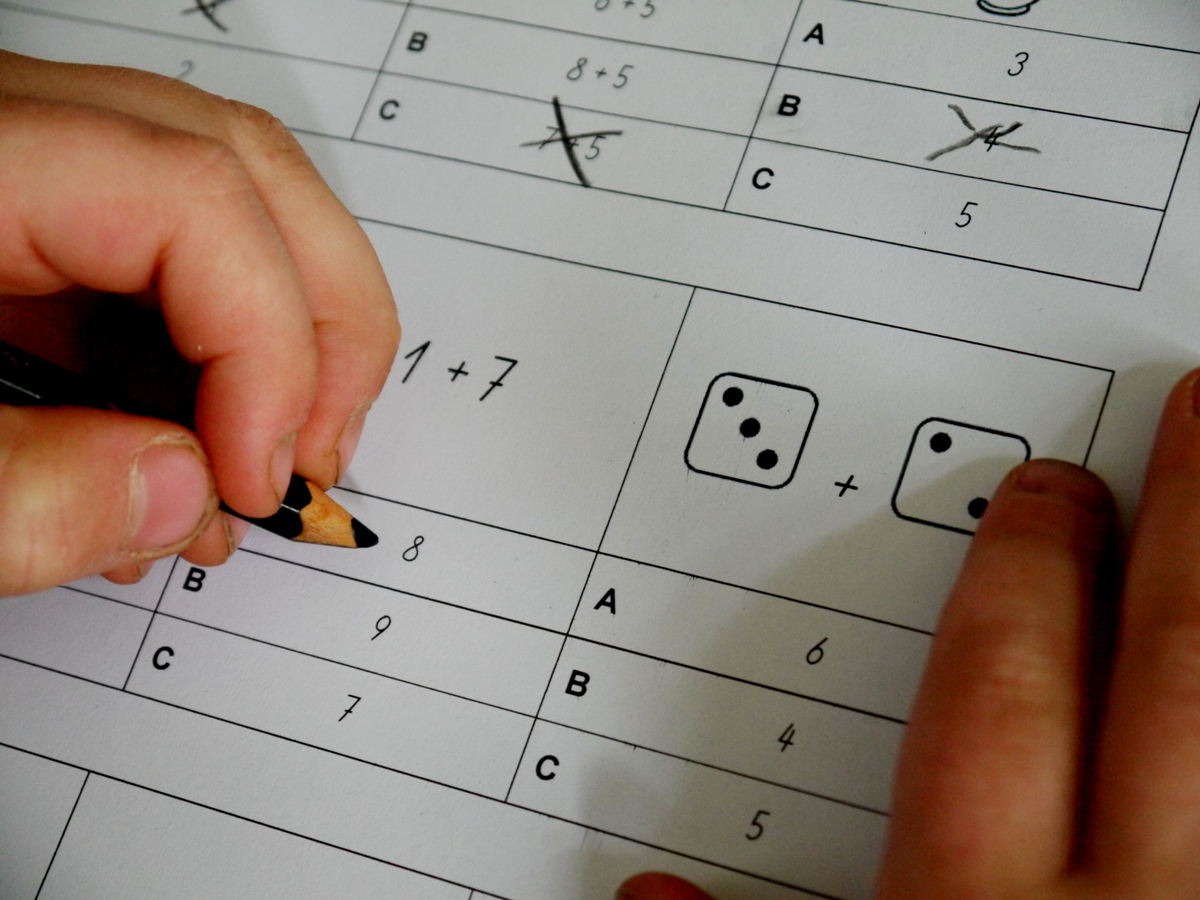Mathematics lessons in RIM (Tier I)
The overall purpose of regular math lessons on the first tier is two-folded: On the one hand, every school child should be given the opportunity to acquire mathematical understanding according to the German education standards required by the German Conference of the Ministers of Education and Cultural Affairs (KMK, 2005). On the other hand, all set curricular learning objectives should be achieved at the end of the school year. In order to accomplish these aims in an inclusive classroom, it is necessary to provide high-quality education that includes a thorough didactical and methodological lesson planning and the creation of a differentiated learning environment. Implemented interventions could be flexible or clearly structured but they should always aim at closing gaps in knowledge. Lesson materials have to be suitable for the development of mathematical understanding despite students' different prevailing learning conditions. The Number Book ("Das Zahlenbuch"; Wittmann & Müller, 2004) comprises exercises and didactical reflections on social forms to meet the demands and needs of every school child in a class. One of the advantages of the Number Book is that educational measures for differentiation often don’t need to be explicitly instructed by the teacher but are realized automatically during active and discovering learning processes of the student (so-called “natural differentiation” [Müller & Wittmann, 1998; Hirt & Wälti, 2008]). Alternatively, the teacher can use the available materials to motivate and control the students’ competence acquisition in a goal-oriented and explicit manner. A broad choice of materials is included in the Number Book, that support educational measures for differentiation with the help of workbooks, exercise sheets and activity-oriented task compilations. The aim is to impart fundamental arithmetic concepts and subsequently to automatize required necessary skills. The process of automatization helps to reduce efforts made by the working memory and create capacities for more complex cognitive processes. For this reason, the course A Quick Math Lesson ("Blitzrechenkurs"; Wittmann & Müller, 2008) is part of the Number Book, which is available either in form of an index card system or as a computer program.
Additional support on the second and third prevention level (Tier II and III)
After diagnosing the need for additional (special) educational support, a child receives further help by the elementary school teacher on the second prevention level. The educational work takes place outside regular lessons but is closely adapted to current lesson contents. Learning essential lesson contents that may lead to fundamental mathematical insights builds the foundation that nourishes further successful learning processes. Students are taught in one or two additional lessons per week in small learning groups of four to six children maximum. Students who don’t respond adequately to educational measures on the first and second prevention level receive additional intensive support in individual case assessments on the third prevention level. Whereas the elementary school teacher carries out educational measures on the first and second prevention level, the special education teacher (in cooperation with the elementary teacher) is responsible for further support on the third level. In order to achieve the learning goals, arithmetic basic competences are developed step by step and with the help of direct instructions. For instance, the special education teacher shows students a clearly structured approach to find a solution for a mathematical problem and practices it together with them in more exercises. In this way, students with severe numeracy disabilities can still take central steps in their development and may even follow regular math lessons again.
For an adequate educational support it is again possible to use materials from the Number Book. This includes a workbook assigned to each grade which is called Understanding and Practicing ("Verstehen und Trainieren"; Müller & Wittmann, 2010). Furthermore, the Number Book provides excellent materials that help underachieving students work in a more structured way (e.g.: field of twenty, chips). They perfectly illustrate mathematical problems so that students can better understand them. Alternatively, teachers can use relevant scientifically proven and evidence-based training programs, such as Calculia (Gerlach, Fritz, Ricken & Schmidt, 2007), or Math Games with Elfe and Mathis (Lenhard & Lenhard, 2010), furthermore the program Sets, Counting, Numbers ("Mengen, zählen, Zahlen"; Krajewski, Nieding & Schneider, 2007) or MARKO-T (Gerlach, Fritz & Leutner, 2013) and the guidelines Productive Learning for Underachieving Students ("Produktives Lernen für Kinder mit Lernschwächen"; Scherer, 2012). We advise mathematics teachers participating in the Rügen Inclusion Model to look into practice-oriented subject literature as they usually suggest useful ideas and materials. They should give additional impulse for lesson designs and educational measures.
References
Gerlach, M., Fritz, A. & Leutner, D. (2013). Mathematik- und Rechenkonzepte im Vor- und Grundschulalter – Training. Göttingen: Hogrefe.
Gerlach, M., Fritz, A., Ricken, G. & Schmidt, S. (2007). Kalkulie. Trainingsprogramm Baustein 1. Berlin: Cornelsen.
Hirt, U. & Wälti, B. (2008). Lernumgebungen im Mathematikunterricht. Natürliche Differenzierung für Rechenschwache bis Hochbegabte. Seelze-Velber: Klett & Kallmeyer.
Krajewski, K., Nieding, G. & Schneider, W. (2007). Mengen, zählen, Zahlen. Die Welt der Mathematik verstehen. Berlin: Cornelsen.
Kultusministerkonferenz (2004). Bildungsstandards im Fach Mathematik für den Primarbereich. München: Luchterhand.
Lenhard, W. & Lenhard, A. (2010). Rechenspiele mit Elfe und Mathis. Göttingen: Hogrefe.
Müller, G.N. & Wittmann, E.Ch. (1998). Mündliches Rechnen in Kleingruppen – Der Förderkurs. Teil 1: Zwanzigerraum. Leipzig: Klett.
Scherer (2012). Produktives Lernen für Kinder mit Lernschwächen: Fördern durch Fordern. Vol. 2: Addition und Subtraktion im Hunderterraum (6. Ed.). Horneburg: Persen.“
Wittmann, E.Ch. & Müller, G.N. (2004). Das Zahlenbuch 1. Lehrerband. Stuttgart: Klett.
Wittmann, E.Ch. & Müller, G.N. (2008). Probieren und Kombinieren 1. Igelaufgaben zum Zahlenbuch 1. Stuttgart: Klett.

